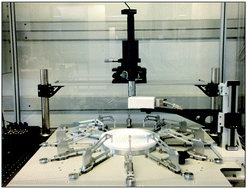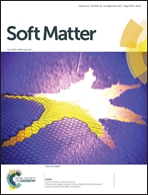Characterization and modelling of Langmuir interfaces with finite elasticity†
Abstract
Interfaces differ from bulk materials in many ways, one particular aspect is that they are compressible. Changing the area per molecule or per particle changes the thermodynamic state variables such as surface pressure. Yet, when compressing to high surface pressures, dense packing of the interfacial species induces phase transitions, with highly structured phases, which can display elastic or strongly viscoelastic behaviour. When these are deformed, in addition to the changes in the surface pressure, extra and deviatoric stresses can be induced. The traditional tool to study the phase behaviour of monolayers is a rectangular Langmuir–Pockels trough, but as both the area and shape of the interface are changed upon compression, the interfacial-strain field in this instrument is mixed with a priori unknown amounts of dilatational and shear deformations, making it difficult to separate the rheological and equilibrium thermodynamic effects. In the present work, the design of a radial trough is described, in which the deformation field is simple, purely dilation or compression. The possibility to now independently measure the compressional properties of different strains and the development of an appropriate finite strain constitutive model for elastic interfaces make it possible to interrogate the underlying constitutive behaviour. This is shown here for a strongly elastic, soft glassy polymer monolayer during its initial compression but is easily generalised to many viscoelastic soft matter interfaces.



 Please wait while we load your content...
Please wait while we load your content...